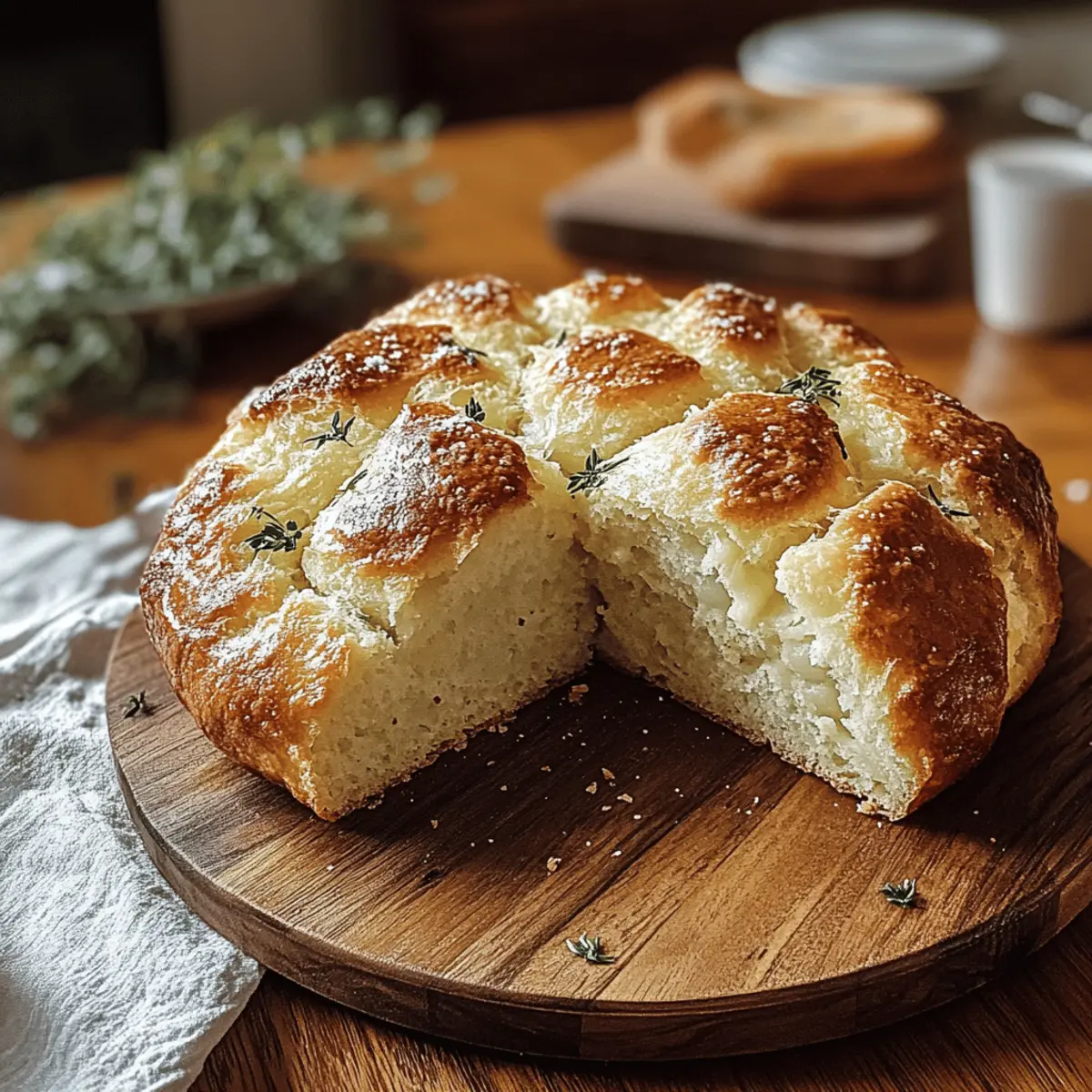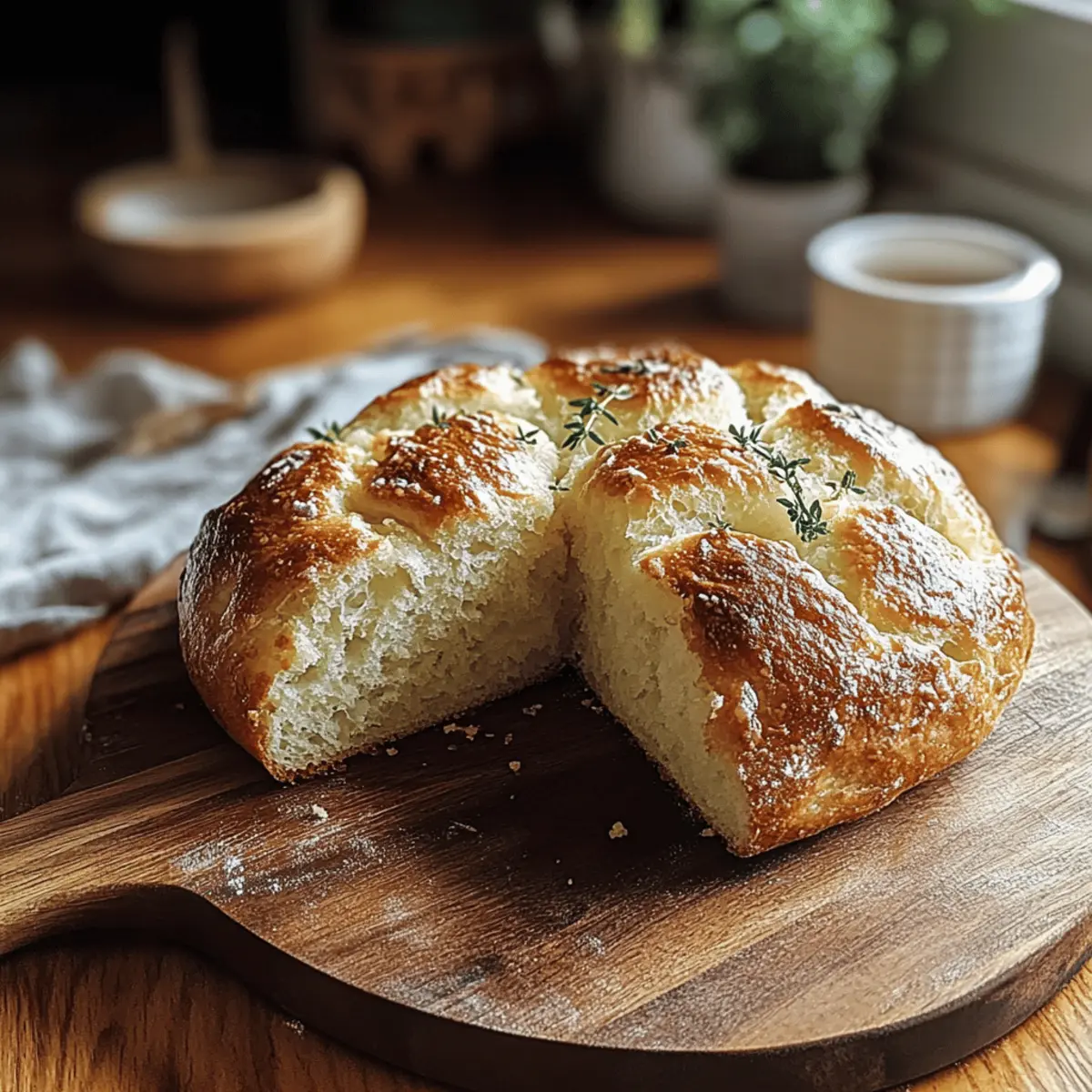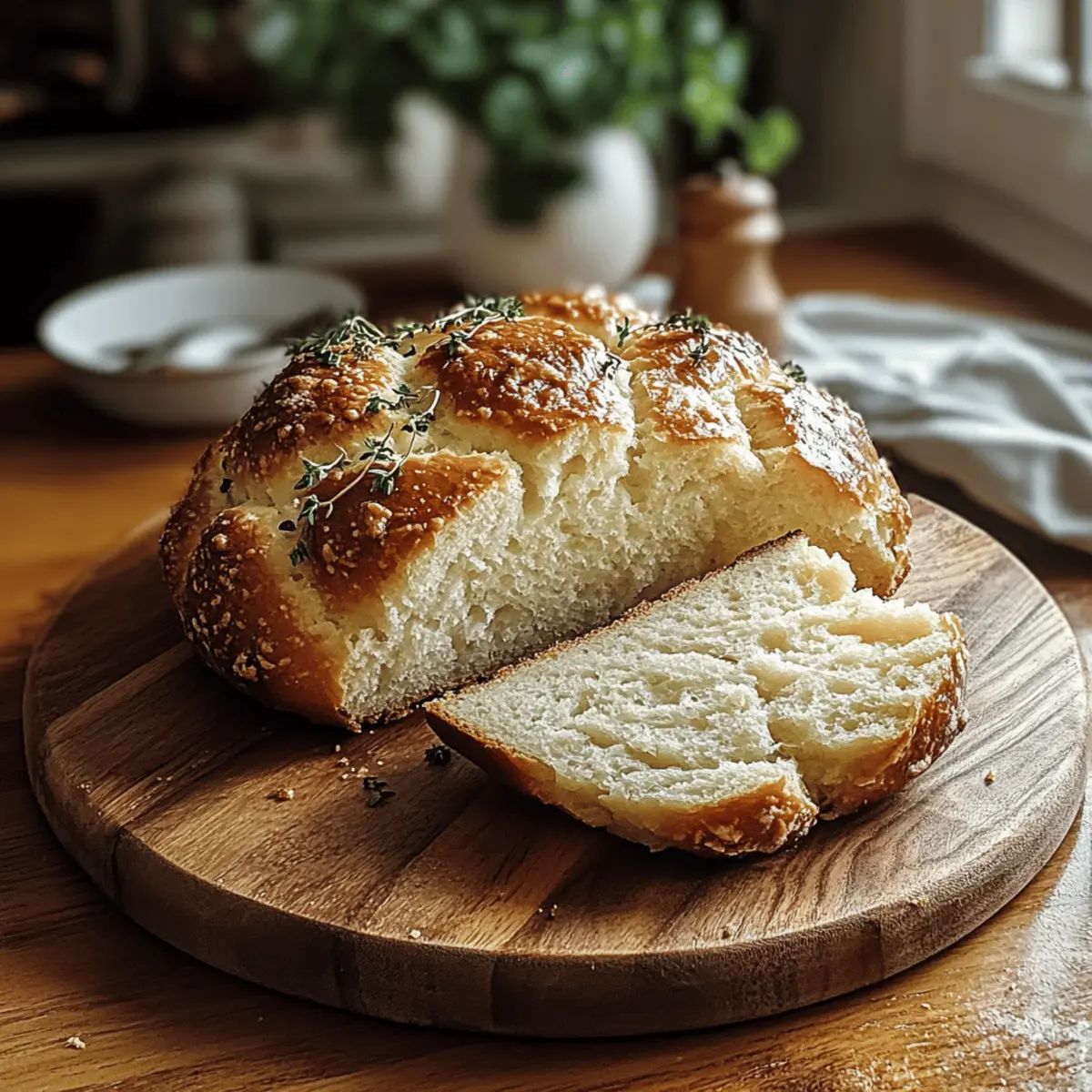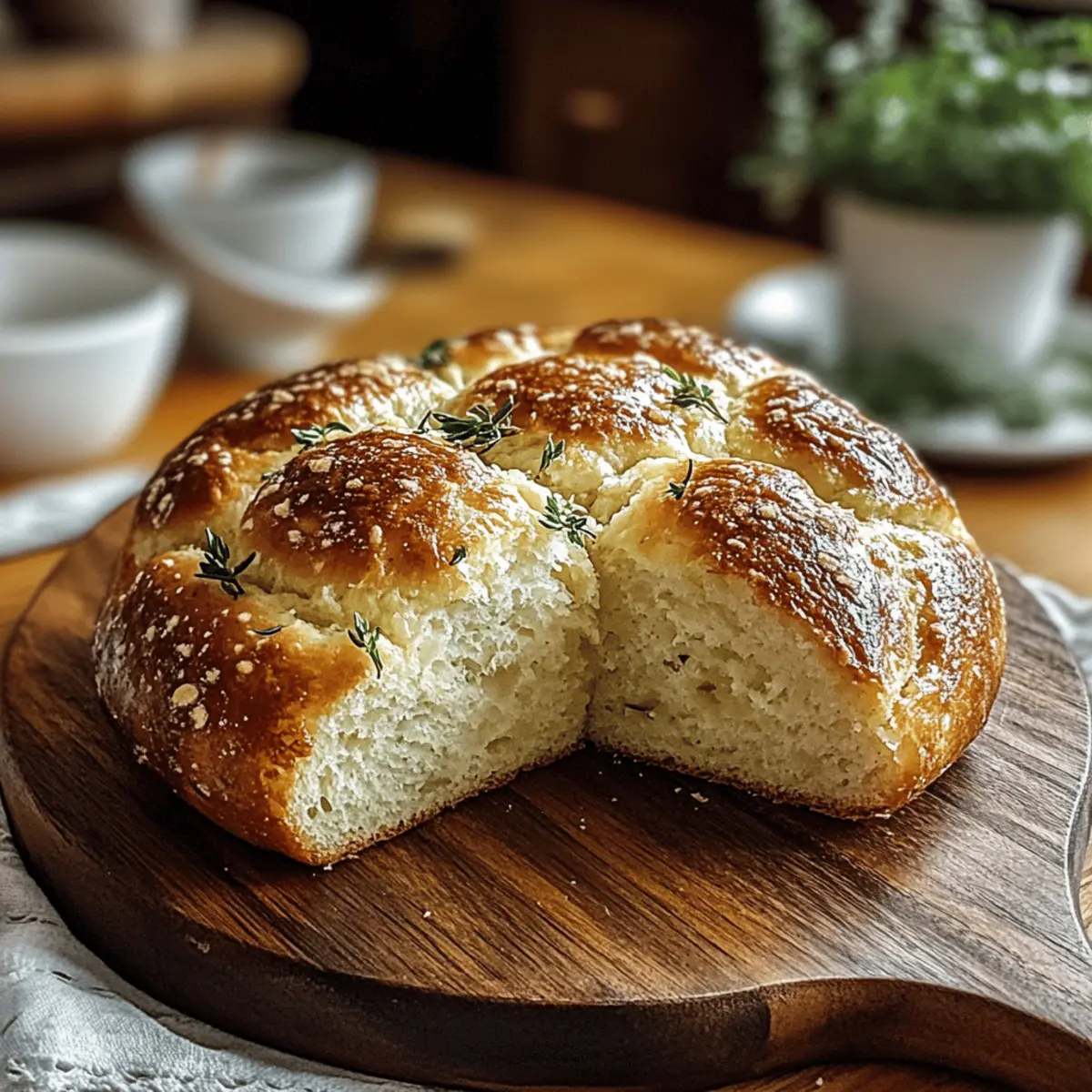As I pulled a golden loaf of Irish Potato Bread from the oven, the aroma enveloped my kitchen like a warm hug on a chilly evening. This comforting bread is not just a recipe; it’s a journey through my family’s cherished traditions and hearty meals. Using simple ingredients, this Traditional Irish Potato Bread is both easy to whip up and a sure-fire crowd-pleaser, making it perfect for any gathering or quiet night in. What’s wonderful about this recipe is its versatility; I often sprinkle in caraway seeds or fresh herbs like chives for an extra twist. Whether you slather it with butter or serve it alongside your favorite soup, this bread brings a touch of home to every meal. Are you ready to embrace the warmth and nostalgia of baking your own?

Why is Potato Bread a Must-Try?
Heavenly Softness: This Irish Potato Bread is incredibly tender, making it the perfect accompaniment to any meal or a delightful snack with just a pat of butter.
Simple Ingredients: With everyday staples like potatoes, flour, and butter, you can create a scrumptious loaf that feels special yet doesn’t require a trip to the store for exotic items.
Crowd-Pleasing Appeal: Whether it’s a family dinner or a weekend gathering, this bread is sure to impress anyone who takes a bite. Pair it with Cheesy Sweet Potato or even a comforting bowl of Sweet Potato Casserole for a satisfying meal!
Versatile Variations: Want to spice it up? Add caraway seeds or fresh herbs like chives for a unique flavor twist that tantalizes the taste buds.
Nostalgic Touch: Baking this bread not only warms your kitchen but also brings back fond memories of family gatherings, creating new stories and connections each time you share it.
Potato Bread Ingredients
For the Bread
• Potatoes – the star ingredient that gives the bread its heartiness; use freshly peeled or leftover mashed potatoes for the best texture.
• Flour – all-purpose flour is essential for structure; whole wheat flour is a great alternative for more fiber.
• Butter – choose unsalted butter for a rich and flavorful loaf, allowing you to control the seasoning.
• Salt – a crucial component that enhances the flavor; opt for kosher or sea salt for a balanced taste.
• Milk – helps moisten the dough; warm milk is best for better ingredient incorporation, but plant-based milk can work too.
• Baking Powder – this leavening agent ensures your bread rises beautifully; make sure it’s fresh for optimal results.
Step‑by‑Step Instructions for Traditional Irish Potato Bread
Step 1: Prepare the Potatoes
Begin by peeling and chopping potatoes into even chunks, then boil them in salted water for about 15 minutes until tender. Drain well and mash the cooked potatoes until fluffy and smooth. If you have leftover mashed potatoes, you can use those too. This will be the heart of your Traditional Irish Potato Bread, providing moisture and flavor.
Step 2: Measure the Dry Ingredients
In a large mixing bowl, sift together 4 cups of all-purpose flour, 2 teaspoons of baking powder, and 1 teaspoon of salt. This step is crucial for ensuring there are no lumps and that all ingredients are well combined, setting a solid foundation for your potato bread’s texture. Once sifted, create a well in the center for the next step.
Step 3: Combine the Ingredients
Pour the mashed potatoes into the well of the flour mixture. Add 4 tablespoons of melted unsalted butter and 1 cup of warm milk. Using a wooden spoon, stir the mixture gently until a dough begins to form. The key here is to ensure the warm milk helps the dough come together smoothly, incorporating all the dry ingredients without overmixing.
Step 4: Knead the Dough
Turn the sticky dough onto a floured surface and begin kneading gently for about 5 minutes. You want to work it just until it becomes smooth and pliable without being tough. Avoid over-kneading, as it might make the Traditional Irish Potato Bread dense. Make sure to keep your surface lightly floured to prevent sticking.
Step 5: Shape the Dough
After kneading, shape the dough into a round disc about 1 inch thick. Place it on a baking sheet lined with parchment paper, ensuring even heat distribution. To give your bread a classic look, score a cross on top with a sharp knife, which will allow it to rise evenly during baking and add a rustic touch to your loaf.
Step 6: Bake the Bread
Preheat your oven to 450°F (230°C). Once heated, place your shaped potato bread in the oven and bake for approximately 25 minutes. You’ll know it’s done when the bread turns a beautiful golden brown and has a delightful aroma that fills your kitchen, inviting everyone to gather around.
Step 7: Cool and Slice
Once baked, remove your Traditional Irish Potato Bread from the oven and allow it to cool for about 10 minutes on a wire rack. This step is important to prevent the bread from becoming soggy. After slightly cooling, slice the bread while still warm, and serve it with a generous pat of butter or a touch of jam for a comforting treat.

Make Ahead Options
These Traditional Irish Potato Bread loaves are ideal for meal prep, helping you save time during busy weeks! You can prepare the dough up to 24 hours in advance; simply shape the bread and refrigerate it uncooked. When you’re ready to bake, let the dough sit at room temperature for about 30 minutes, then score and bake it as directed. Alternatively, you can make the bread up to 3 days ahead; after baking, allow it to cool completely before wrapping it tightly in plastic wrap and storing it in an airtight container to keep it soft. Just remember to slice and serve warm with butter or jam for a comforting treat that feels freshly baked!
What to Serve with Traditional Irish Potato Bread?
The warmth of freshly baked potato bread invites a delightful spread of flavors and textures to create a beautiful meal.
-
Rich Irish Butter: A classic pairing that enhances the bread’s flavors, melting into each warm slice for a comforting experience.
-
Hearty Vegetable Soup: A steaming bowl of soup complements the bread’s texture, making every mouthful a cozy delight on chilly evenings.
-
Savoury Herb Salad: A crisp salad with chives or rosemary brightens the meal, contrasting the soft bread with its refreshing crunch.
-
Cheddar Cheese Platter: Sharp cheddar alongside slices of potato bread adds a savory richness, perfect for snacking or appetizers.
-
Homemade Jam: The sweetness of jam spread atop the bread offers a wonderful balance, turning it into a delightful breakfast treat.
-
Garlic Roasted Vegetables: Tender roasted veggies add a touch of earthiness, making for an inviting and colorful side dish at your dinner table.
For a perfectly rounded meal, consider serving a glass of crisp apple cider or a lovely herbal tea to enhance the flavors beautifully.
Expert Tips for Potato Bread
• Warm Potatoes: Use warm mashed potatoes for better mixing and a smoother dough, ensuring even texture in your potato bread.
• Knead Gently: Avoid over-kneading; knead just until the dough is smooth. Overworking can lead to a tough texture instead of the desired softness.
• Rest the Dough: Allow the dough to rest for 10 minutes before shaping. This relaxes the gluten, resulting in a fluffier potato bread.
• Fresh Baking Powder: Always check the freshness of your baking powder. Using fresh ingredients is key to a well-risen loaf.
• Store Properly: Keep leftover potato bread in an airtight container to maintain softness and can even freeze for longer preservation.
Potato Bread Variations & Substitutions
Feel free to let your creativity shine! This recipe is a canvas for your taste buds.
-
Herbed Delight: Add a tablespoon of fresh chopped herbs like rosemary or chives to the dough for aromatic bursts of flavor.
-
Cheesy Bliss: Mix in shredded cheese, such as cheddar or mozzarella, for a heartier loaf that’s all about comfort.
-
Whole Grain: Exchange all-purpose flour for whole wheat flour to boost fiber and add a nutty flavor that complements the potatoes beautifully.
-
Nutty Crunch: Fold in a handful of chopped walnuts or pecans for a delightful crunch and unexpected twist.
-
Caraway Infusion: Incorporate caraway seeds into the dough for a hint of traditional flavor that pairs well with butter.
-
Spicy Kick: Stir in a pinch of red pepper flakes or diced jalapeños for a spicy loaf that’s perfect with your favorite soups.
-
Sweet Addition: For a sweeter twist, add a tablespoon of honey or a sprinkle of cinnamon to the dough, creating a fantastic breakfast treat.
-
Plant-Based Twist: Swap out the butter for olive oil and the milk for almond or oat milk to make this recipe plant-based without losing any flavor.
These variations can take your Irish Potato Bread to new delightful heights! Why not enjoy a slice alongside a comforting bowl of Sweet Potato Casserole or pair it with a warm cup of soup like our Cheesy Sweet Potato for a cozy dinner?
How to Store and Freeze Potato Bread
Room Temperature: Store your homemade Potato Bread in a cool, dry place in a sealed bag or container to keep it fresh for up to 3 days.
Fridge: While it’s not necessary to refrigerate, if you live in a humid environment, you can wrap the bread tightly in plastic wrap and place it in the fridge for up to 5 days.
Freezer: For longer storage, wrap the Potato Bread in plastic wrap and then in aluminum foil before freezing. It can last up to 3 months in the freezer.
Reheating: To reheat, simply thaw at room temperature or pop it in the toaster for a few minutes to enjoy that fluffy texture fresh out of the oven.

Potato Bread Recipe FAQs
What type of potatoes should I use for potato bread?
I recommend using starchy potatoes like Russets or King Edwards for the best texture. They provide the perfect moisture and fluffiness to the bread. You can use freshly peeled potatoes or leftover mashed potatoes for convenience.
How should I store leftover potato bread?
Store your homemade Potato Bread in a sealed bag or airtight container at room temperature to maintain its softness for up to 3 days. If you want to keep it longer, consider wrapping it tightly in plastic wrap and then in aluminum foil to prevent freezer burn.
Can I freeze potato bread?
Absolutely! To freeze, wrap the cooled Potato Bread in plastic wrap, ensuring it’s airtight, then wrap it again in aluminum foil for extra protection. It can be stored in the freezer for up to 3 months. To enjoy, simply thaw it at room temperature and reheat in the oven or toaster for that fresh-baked taste.
What should I do if my potato bread comes out dense?
If your bread turns out dense, it may be due to over-kneading or not enough rising time. Make sure to knead just until smooth and rested, and ensure your baking powder is fresh to help the bread rise correctly. You can also try to lightly shape the dough without a lot of force during the shaping step.
Is potato bread suitable for people with gluten allergies?
Traditional Potato Bread contains gluten from the flour, so it’s not suitable for individuals with gluten allergies. However, you can substitute the all-purpose flour with gluten-free flour blends specifically designed for baking, keeping in mind that this may alter the texture. Always check labels for cross-contamination if needed.
Can I add flavors or herbs to my potato bread?
Very! I often add caraway seeds or fresh herbs like chives or rosemary to elevate the flavor profile. Feel free to experiment; adding about 1-2 tablespoons of herbs into the dough can bring a delightful twist that complements the bread wonderfully!

Heavenly Soft Potato Bread – Your New Comfort Food Delight
Ingredients
Equipment
Method
- Begin by peeling and chopping potatoes into even chunks, then boil them in salted water for about 15 minutes until tender. Drain and mash the cooked potatoes until fluffy.
- In a large mixing bowl, sift together 4 cups of all-purpose flour, 2 teaspoons of baking powder, and 1 teaspoon of salt.
- Pour the mashed potatoes into the well of the flour mixture. Add 4 tablespoons of melted unsalted butter and 1 cup of warm milk. Stir gently until a dough begins to form.
- Turn the sticky dough onto a floured surface and knead gently for about 5 minutes until smooth and pliable.
- Shape the dough into a round disc about 1 inch thick and place it on a baking sheet lined with parchment paper.
- Preheat your oven to 450°F (230°C) and bake for approximately 25 minutes until golden brown.
- Once baked, remove from the oven and allow to cool for about 10 minutes on a wire rack. Slice while still warm.

Leave a Reply